Guajarati’s live in Gujarat. The name comes from “Gujara,” a branch of the White Huns. After India’s independence in 1947, Gujarat was incorporated into Bombay state. In 1960, the Gujarati-speaking areas of Bombay were split off to form the present-day Gujarat. Gujarat is the place to visit if you are on a textile tour to India. The state excels in both quality and designs of textiles, both customary and recent.
TEXTILES OF GUJARAT
Gujarat has a large flourishing textile industry which contributes to the arts and crafts of India. The textiles have a large variety to offer to the end consumers. It mainly depends on factors like varied raw materials, combination of yarns and effective use of traditional techniques. The enriched range of textiles owes to the people of different communities, castes, tribes and regions of the state, who have kept the age old tradition alive.
Patola

https://www.indiamart.com/proddetail/patan-patola-saree-14378226588.html
History: – It is called `PATTA’ in Sanskrit and mentioned since 1342AD.
- 100 weaver from the Salvi community migrated from Maharashtra and Karnataka to Gujarat on request of the king Kumar pal of the Solanki dynasty who needed Gujarat and Malan (Rajasthan) in the 12th century. Now only 3 families are left. Traditionally also worn in Malaysia, Indonesia, Sumatra, Basra and Rome where it were highly priced.
Place:- The main traditional place in `Patan’ were only the `Salvi’ family makes it. Now also manufactured in Rajkot and Khambat. Today some weavers have resettled in Pochampally and also make ikat design similar to Patola but usually only warp and weft and weft are tied and dyed, they are called `Hyderabadi Patola’ or single Ikat fabrics.
Fibre:- Pure mulberry spun silk (therefore less shine), Pure gold zari.
Colour used:- Maroon is the most dominating colour in most saris. Red, yellow, green, blue, white, black are also used but black is not used in wedding saris.
Manufacturing Technique:- Double Ikat i.e. warp and weft yarns are both tie-n-dyed. Then woven on a simple two harness handloom made of rosewood and bamboos. Originally wax threads were used for resist tying (now rubber tyres).
Style of sari used:- The border and pallu is a solid gold band. Width of the border may be made of single stripes of various colours to reduce cost. Pallu has weft gold yarn. And designs are placed in checks woven in the body either in gold or contrast threads. Now a days the sari is contemporised therefore border and pallu had zari border with motif in it and body has motif scattered throughout. Pallu- 1 to 1.5 feet of gold band, Border- 4 to 6 inches.
Motif: – Motifs are called `Bhat’.
- Elephant is considered as auspicious and thus most common along floral design.
- Elephant- Kunjar bhat.
- Tiger and Elephant- Vagh Kunjar bhat.
- Parrot and Elephant- Tota Kunjar bhat.
- Peacock and Parrot- Mor-Tota bhat.
- Flower design- Phul bhat.
- Leaf design- Paan bhat.
- Walnut design- Akrot bhat.
- Diamond/Kite- Patang bhat.
- Gopi and Krishna’s- Raas bhat.
Bandhani

https://www.wholetex.com/wholesale-catalogs/syb-bandhani-cotton-sarees
Note the Bandhani is a tie-n-dye technique used at fabric stage and Patola is tie-n-dye technique used at the yarn stage.
Place: – Although now made everywhere, traditionally there were 4 main centre’s- Kutch, Bhuj, Jamnagar, Rajkot.
Fibre: – Fine cotton and fine silk(usually mulberry). Now a day’s chiffon, georgette and crepe silk are also used.
Colour: – All bright colours.
Designs: – Kalash, Swastik, Dancing doll, Elephant, Floral and Geometrical designs.
Manufacturing Techniques:- The resist style of dyeing is used. It has smaller dots and more complicated designs (as compared to Rajasthan). It is made in three stages by three experts.
- Chitranar: – He prepares wooden blocks on which the designs id made by nails pointing upwards. The fabric is folded as points on the folded fabric.
- Bandnnar: – The second expert ties these points which makes the designs.
Generally it is made by young girls who grow long nails or wear iron nail like extension on their fingers to help picking layers of fabric together wax threads are used for the process.
- Rangnar: – The fabric is next dyed by the Rangnar. Usually the dyeing is done with the lightest colour first (yellow).
The fabric is then retied based on the design and redyed. Thus with each new colour all steps are followed again. The fabric is then dried and opened only when sold to the customer.
Style of Sari used: – These sari may have a border and pallu or completely covered with a single design. It has a yellow border between the body and border or body and pallu (which is missing in Rajasthan saris).
Bandhani is of 2 types:-
- Gharchola:- Wedding sari’s usually red sometimes green in colour. Zari checks are worn in 2inches or 3inches inside each check the motifs are done in tie-n-dye.
- Chunnari/Chunnadi:-Cotton work is less elaborate. Any bright colour is used. It could be Panch rangi/Nav rangi. The sari has 5 or 9 colours with golden yellow in the middle and design in white dots. The fabrics are usually folded into half or four times to give a diamond in the centre.
Lehariya

https://pngimage.net/saree-girl-png-4/
Lehariya is also a type of tie-n-dye where the design is made of diamond strips. Very fine fabric is used. It is easy to identify as it has uneven width strips throughout the length. That is how it can be identified from fake printed versions which are of even width throughout. Real laheriya has even broad colour strips outside and thinner coloured strip as you move inside with more of white in it. It is normally of a single colour.
Dhamadka and Ajrakh

https://khamir.org/unique/piece/peaks-saree
Dhamadka is the art of
printing fabrics with wooden blocks. This is a major foreign exchange earner of
the region, along with the modern screen printing art. The technique uses
wooden blocks of around 1 ½ ” to 3″ thickness. The design to be printed
on the fabric is first pin pricked on the wooden surface and later chiselled.
After this, the blocks are dipped in different colours and stamped across the
fabric. This leaves an imprint of the design of the block on the fabric. After
printing, the fabric is fixed in river Gondali and spread to dry.
Dhamadka is widely practiced along the riverside
town of Jaipur, midway Gonadal and Junagadh. Its block prints are well known
for the river water which brightens the colours of the fabric. Dhamadka block
printing is available in a range of contrasting colours like maroons, yellows,
blues and reds with patterns generated through tiny dots. Another popular area
of printing is Kutch. Apart from block printing, artisans here also use
vegetable dyes, paraffin wax resist and patricide-printing material. Though
synthetic dyes and modern techniques have come up, bright Ajrakh prints are
still in vogue.
Mushroo

https://jigarvanzamashru.blogspot.com/2013/05/mashru-weaving.html
Mushroo is a mixed fabric, woven with a combination of cotton and silk. It was originally used by Muslim men, as they were prohibited from wearing pure silk. This weaving technique was prevalent in Iraq and the Arab countries. This might have been the influencing factor for the rise of Mushroo tradition in India. It was once woven in the whole country, but has now been confined to the state boundaries of Gujarat. Patan is one of the most important centres of Mushroo weaving. It is practiced in different styles, like ikkat patterns in stripes, with extra warp threads, by the depression of the warp threads and even on a pit loom.
Nagari Sari
It is a coarse cotton sari with a maroon background and black dot design printed on it. It is a half sari usually 3-3.5m long. It is worn by rural women.
Tangalia Shawls

https://www.fibre2fashion.com/industry-article/6923/tangaliya-the-lesser-known-textile-craft-of-saurashtra-gujarat
Place: – Dungshia (not done anymore), near Ahmedabad by tribal
Fibre: – Woollen warp and weft fine yarns are used.
Colour: – Black or rust colour.
Design: – Woollen thread or any other light colours. It is always geometrical with woven border. It looks like bead work and small white motifs on black background.
Dhurries

https://www.gujaratexpert.com/arts-and-crafts-of-gujarat/
Most of the villages in Gujarat are famous for weaving some of the fine carpets, blankets and rugs. Woven on the primitive pit looms that is unique to the villages of Kutch. These Dhurries are in great demand all across the globe. These Dhurries involve a lot of hard work as they are made by hand. The carpets and rugs are known for their beautiful designs colours schemes and intricate weaving.
- Dhablo:- Made from coarse woollen yarns, it is thick usually white or light grey in colour. It is used as blankets and floor coverings. Sometimes multicolour geometrical designs are woven. Usually checks are used. Colour of strips are pink, blue, yellow and green.
- Kambals:- Fine dhablas are called Kambals, always black or dark steel grey in colour. Usually checks are woven in red or green colour. They have fringes on both sides.
Just like the diversified geographical aspect of Gujarat, the costumes of Gujarat too show a remarkable variety across the various communities inhabiting the state.
Traditional Dresses of Gujarati Men
Chorn
Chorno is a type of cotton pants that the Gujarati men wear. It looks like a stitched dhoti and is very loose and comfortable. Chorno either has a string to tie at the waist or have elastic.
Kediyu
Kediyu is a garment that is worn above the Chorno to cover the top part of the body. A Kediyu is frock type kurta with frills, worn by the men in Gujarat. Kediyu is also referred to as Angrakhu.
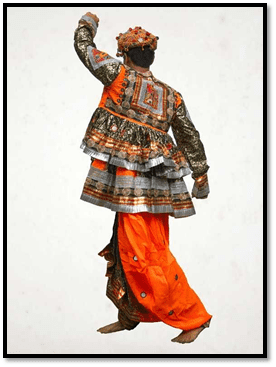
https://www.holidify.com/pages/gujarati-dresses-125.html
Dhoti
Dhotee or dhoti is a long piece of garment that is wrapped around the
lower body of men. The garment is wrapped around the waist and tucked from
between the legs. Gujarati men wore white or light coloured dhotis for normal
wear.
Kurta
A kurta is the top worn to cover the torso of men. The Kurtas for
everyday use are made up of cotton. Festive kurtas may have embroideries or
some designs in them.
Phento
Phento is a headwear or a turban worn by Gujarati men, especially in rural area. It consists of a layered cloth wrapped around the head.

https://in.pinterest.com/pin/174303448056234597/
Traditional Dresses of Gujarati Women
Ghagra Choli or Chaniya Choli
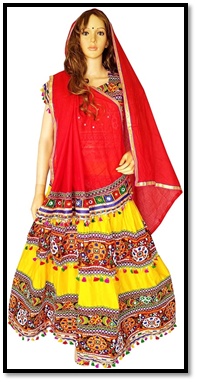
https://www.amazon.com/Traditional-Lehenga-Kutchi-Dress-Navratri-Gujarati-Costume-Embroidered/dp/B07QG5YLYL
The traditional attire of Gujarati women is Chaniya Choli or Ghagra Choli; Women also wear an Odhni (dupatta or chunni) with it.
Chaniyo
The Chaniyo or lehengas is a coloured petticoat or skirt-like garment worn
by the women. The Chaniyo is designed with mirrors and thread work.
Choli
The women wear Polku or Choli on the top. It is an embroidered short
blouse.
Chunni
Chunni, Odhni or dupatta is an elongated piece of cloth to complete the
dress. The churn is worn diagonally and is used to cover their heads.
The women may also wear Kurtas instead of Choli known as Zhabo and lehenga along with it.
Sari

https://fashionbuzzer.com/sari-can-style-statement-every-occasion/gujarati-style-sarees/
A sari is a long piece of garment that is wrapped around the woman’s body, and the excess or the end is wrapped around the shoulder. However, the Gujarati women wear sarees with the end of the sari in the front.
The Gujarati women carry house keys with them tucked into the sari that wraps around their waist with the help of the silver hook. This is because traditionally their role was to look after the house and house-related tasks.
COSTUMES OF TRIBES
This historically significant Western state of India is famous for education, tourism, tradition and its people. Along with local people, Gujarat also houses various tribal communities along the length and breadth of the state.
Rabari
Rabari tribe have migrated from the Mediterranean region are mainly pastoralists. Rabari are found in the Kutch region. Rabari people are divided into 5 sub-groups called Debar, Gardo, Kantho, Katchi and Ragad.
Rabari males wear turban and cotton white trousers while females wear jacket or open blouse, skirt, silver coloured heavy jewelleries and bangles in upper arms.
Bhils

https://webtokri.com/tribes-india-portrait-rabari-tribe-kutch/
The largest and most popular tribal community of Gujarat is the Bhils who live in parts of Surat, Bulsar, Banaskantha, Baroda, Dangs, Sabarkantha and Broach.
The traditional dresses of men are Pagri, Angarkha, Dhoti and Gamchha. Traditionally women wear Sari and Ghagra Choli.
There are many traditional ornaments of Bhils. Men wear Kada, Bajuband, Chain, ear rings, Kardhani. Women wear variety of ornaments including hansli, ring, Zele-zumke, ear ring, narniyan (bangle), nathni(Nose-jewel) etc. Tattooing is traditional custom among them. Women folks do tattooing generally before marriage.
Ahir

https://thelastavatar.in/ahir-tribe/
Ahir tribal communities have travelled from Sind and have settled in the Morvi and Kutch in Saurashtra of Gujarat. Ahir people mostly depending on cow herding and cultivation for their livelihood.
Both Ahir men and woman wear kehdiyun and baggy trousers with white loosely head cloth and heavy silver coloured jewellery. They worship many Gods like Krishna and Naga and celebrate festivals like Dussera and Navaratri by singing folk songs and playing Dandiya.
Bharwad
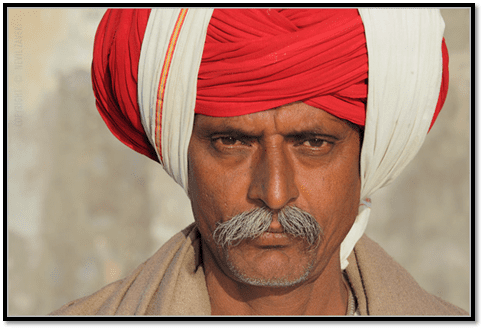
https://en.wikipedia.org/wiki/Bharwad
Bharwad tribe has drifted to Gujarat from Mathura in Uttar Pradesh and said to be followers of Lord Krishna. They are found in forested areas of Vadodara and peripheries of Gir forest of Junagadh district and mostly live by forest grazing.
Bharwad males wear turban and cotton white trousers and woman wear backless top covered by veils and skirt along with heavy jewelleries. Their cloths are vibrant and mostly have designs of flowers, parrot and peacock. Bharwad tribe celebrate their annual Tarnetar fair along with Janmashthami and Navaratri.
Siddi
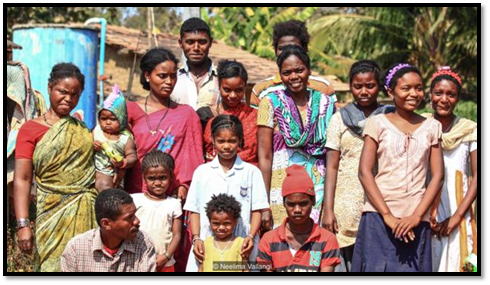
https://www.bbc.com/travel/story/20160801-indias-forgotten-jungle-dwellers
Siddi Tribe in Gujarat is also reckoned as the Lost Tribe of Africa. The people stayed on in India and are still found in Gir in Gujarat as a district tribe
The dress of the Siddi is a combination of traditional Hindu and Muslim dress. The males wear patloon (trousers), khamij (shirt) and safo (turban). But now-a-days, they mostly use pant and shirt. The females use sari or a ghagro (broad petticoat) and choli.
EMBROIDERY OF GUJARAT
Kathiawar Embroidery:-

https://www.aamori.in/BluePakkoTabletBag
- Also called as embroidery of Kutch, Kathiawar and Saurashtra.
- Motifs used are not the same although the stiches are similar. Sindh embroidery is influenced by Punjab Economical and Social aspects also have influenced sind embroidery. Due to ruling of Britishers and the refugees coming and going from Pakistan. So again the embroidery was influenced by Phulkarie of Punjab.
- Kathiawar gets its name from `Kathis’, who were a landlord caste and the fine practioners of the Khatipa style of embroidery.
- History- Lord Krishna killed Jara Sangh and rescued 1600 ladies from him and later married all of them to give them respectability. As a token of love the ladies produced their own state embroidery and presented to lord Krishna. These embroideries were later combined together and were named as Kathiawar embroidery.
Aari Embroidery: – Aari Bharat or Chain Stitch

https://www.kashmirbox.com/products/rose-pink-hand-aari-floral-cotton-kaftan-1
- It is famous from Bhavnagar a state in Gujarat.
- History- In 12th century, mochis did this work on leather bags and shoes, In fact legend says that it was taught to the poor mocha who fed and gave shelter to a saint. In return he taught the mocha this art to help develop a source of income and improve his standard of living. Regained popularity during Mughal period.
- It consist of chain stitch work. The work is done with an aari which looks like a very fine and thin crochet needle. Very fine and small stitches are done.
- Motifs are Parrot, Peacock, Floral design, Lady standing with flowers in her hand, Palki, Elephant, etc.
Zari Aari:-

https://aarinaari.com/what-is-aari-work-materials-used-for-maggam-work/peacock_highres-2/
The zari industry of Surat is one of the oldest handicrafts whose origin can be tracked to the Mughal period. Surat is today one of the biggest and most significant zari manufacturing centres in India.
- The principle type of products is real gold and silver threads, imitation gold and silver threads. Dabka (flattened metal threads twisted around the silk threads), Badla plain wires. Other materials are gold, sequences, chalak, salama, Kangali, tikki and katori.
- Aari work is generally associated to floral motifs. Zari work is also used along with bandhani to give the fabric beautiful look. Jamnagar, Mandavi and Bhuj are the places especially for its Bhandhan work across the world.
Sindhi Tarupa:-

https://www.pinterest.nz/amp/pin/511932682614744183/
- Used in Sindh embroidery it is an interlacement stich or `Maltise Square’ It is originally from region of Baluchistan later Afghanistan but was extensively practised in Germany too. It is done in Khaipur and Mirkhapur district. The basic structure is made as a skeleton with long stitches and then together into geometrical pattern or boarders.
- It also looks attractive as it is done in combination or with Abla or Mirror work. And all the motifs are attached together with herringbone stitch, especially as an outline around the mirror.
- Bright and dark colour like black. Maroon, golden yellow and red. It gives a bold effect because of the big motif and bright colours.
Abla or Abhala:-

https://in.pinterest.com/pin/147211481541481466/
- It is influenced by Kathiwad. It is done by the Banjara community. Shiny floss threads are used for the mirror work. Sometimes chain stitch or herringbone stitch is also done around it, which is the influence of Kutch embroidery. Done on ghagra cholis, blouses, chakla, etc.
- Dark bright colours are used such as indigo blue, red, pink, and yellow, green, orange.
Katab or Applique work:-

https://in.pinterest.com/pin/397794579557518938/
- French word applique whose meaning is to “put on”. It is placement of two fabrics one as a design and one as a background. Usually it is as cotton base and cotton applique or satin base and satin applique. The design is first traced on the background to identify the patches placement. The design is also traced on another fabric, cut with a margin and traced on another fabric.
- It is usually done on Ghagra Cholis. They are made of big patchwork borders with small designs in chain stitch inside the body of the garment.
- Sometimes mirrors are also used.
- Articles:- Chakra- Triangular shaped wall hanging, Torran- Used on celling doors, it has different flaps each flap has different designs either with chain stitch or applique work.
Heer Bharat:-
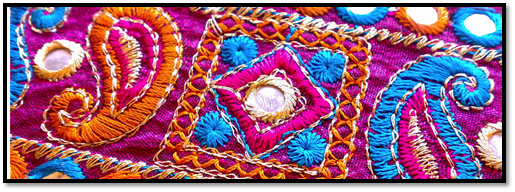
https://in.pinterest.com/pin/773704410953072386/
- Silk floss or untwisted silk threads was used for embroidery or darning stitch which constituted a major part of this style. It looks like phulkari embroidery.
- Always long stitched sometimes up to 1 inch is used i.e. in square both vertical and horizontal stitches are done. Sometimes mirror is used together to give emphasis to certain part of the design.
- Mostly geometrical patterns such as squares, rectangles, triangle etc. These designs look harmonised and shadow effect is created.
- Common colours are blue, crimson.
Moti Bharat or Bead Work:-

https://www.dsource.in/resource/moti-bharat/products
- Done by the Kathis tribe. It is a technique of doing embroidery and not a stitch. Moti bharat does not require and background.
- Common motifs- Swastika, Kalash, Elephant, Calf, Dolls etc.
- White background beads with green and red beads, for motifs are used.
- Articles- Toran when used on doorways, or articles of decoration such as vases, coconut, shape, for weddings, jewellery etc.
Meghwal Embroidery:-

https://www.flickr.com/photos/tse_tse/16785441825
- Meghwals they consider them to be down line of Megh rishi and Mahatma Gandhi named them harijan, Gods owns People. Their house and embroidery is very beautiful, they also use mirrors in the embroidery and the house have beautiful mud and mirror work inside.
Mata Ni Pacheadi:-
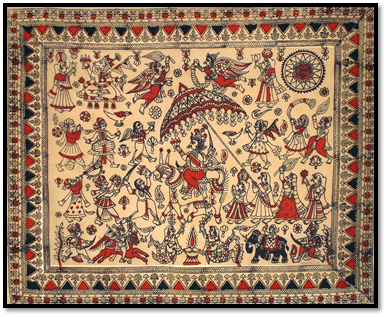
https://readingcloth.blogspot.com/2013/10/mata-ni-pachedi-fading-folk-art-form.html
- The Cloth of Goddess Mother, or Mata ni Pachedi, as the term is popularly called, is a very popular narrative scroll from Gujarat. These were made by the Vaghris, the wandering caste. The Vaghris were once a wandering caste, some of whom have now settled in Ahmedabad, the great industrialized city of Gujarat First they take a block and it is printed and then later they fill in the colours using a stick like the same way Kalamkari work is done.
Embroidery of Kutch:-
- It is the western region of Gujarat. In Kutch most embroidery is done by the ‘Rabai’, ‘Kandi’ and sometimes ‘Ahir tribes’. It is done by women only. It is very delicate, it is in great demand but yet no organised large cottage industry.
- Common motifs are parrot, peacock, and elephants along with flowers.
CRAFT AND CULTURE OF GUJARAT
Gujarat is one of India’s leading states in business and commerce and has a richly varied heritage of art and culture which finds its roots in rural and cottage activities and livelihoods. Gujarat has a richly diverse tradition of folk arts, crafts and culture.
Jewelleries and accessories:-

https://www.gujaratexpert.com/arts-and-crafts-of-gujarat/
Jewelleries & accessories make an integral part of the traditional Gujarati costume look. The jewelleries complementing the traditional Gujarati costumes are generally heavy, artistic and intricately crafted. Women wear jewelleries like bangles, earrings, necklaces, chains, nose pins and rings. They also flaunt ornate, tassel key rings on their waist perhaps to accentuate the beauty of their hour glass waist! Married women have Mangalsutras strung around their neckline and apply vermilion or Sindoor on the parting of their hair in order to symbolize the holy bond of Marriage. The Gujarati men may wear golden chain & ring and accessorize their outfit with an embellished turban. Women in the interiors of Gujarat; i.e. in the villages, adorn themselves with tribal metallic/silver jewellery which is much of a rage in the modern fashion world right now.
Brass and Iron Items:-

https://www.gujaratexpert.com/arts-and-crafts-of-gujarat/
Gujarat is one of the major producers of Brass and Iron items in the country. Mostly produced in the princely state of Saurashtra and Kutch brass and iron the most common items available here are copper coated iron bells, beetle nut crackers and cutlery knives. These magnificent works of art are created by the descendants of the erstwhile court jewellers and sword smiths. The place is also popular for its range of Brass items which include brass and iron utensils, cutlery, knives and scissors.
Lippan Kaam – mud relief work:-
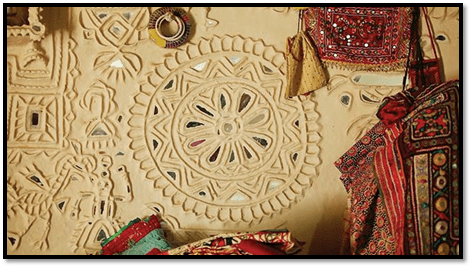
https://www.asianpaints.com/colourquotient/showcase/lippaikaam–an-artform-from-kutch/
- The application of small round mirrors also extends to the walls of homes. The buildings are traditionally round mud huts with thatched roofs, very plain simple and suitable for the climate, however the decorations inside and out can be stunning.
- This technique has been perfected by a few individuals as a form of up-market interior design and can be seen in some five star hotels and in films.
- The Kachchhi Rabari, (a sub-tribe of the Rabari) is excellent in this art form but it may be on the verge of extinction as the younger generation are not so interested in this work. The hamlets of Banni are full of this art and on every house you can see walls that are embellished with mud relief work. The designs used are influenced by their own embroidery; geometrical forms, pheasants and women with water pots are the most auspicious signs for this community.
Clay Items:-
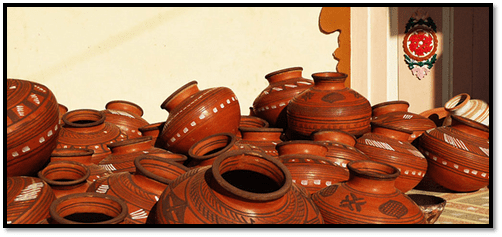
https://www.theindianway.in.net/colors-of-western-india-gujarat.php
The art of Pottery is among the oldest and most appreciated art and crafts of Gujarat. The artisans who are generally ordinary rural locals are masters of the art of mouldings clay into well-proportioned utensils. After the creation of these utensils they are painted with vibrant colours that add to the beauty of the pot. The artists of Kutch are renowned worldwide not only for their pottery but also for their variety of Terracotta toys.
Paintings:-

https://www.openart.in/history/pithora-paintings-central-gujarat/
Paintings in Gujarat are well-known and identified as styles of miniatures, mostly of religious themes. Long after the foundation of the gujarat Sultanate in the 15th century and the establishment of the Mughal rule at the end of the 16th century, paintings in gujarat maintained its angular features as well as its gorgeous and bold colours.
Woodcraft:-

https://mygujarat2796.ultimatefreehost.in/art-gujarat-wood-carving-gujarat/?i=1
Woodcraft is a traditional art in this state that exhibits the unique art of beautiful wooden handicrafts. These woodcrafts serve the purpose for utilitarian and also for architectural purposes.
In Vadodara district, a place called Sankheda is well-known for its colourful wooden furniture. It is a perfect example of woodcraft, woodturning, and hand-painting on wood. There is an artisan community which is called Kharadi Suthars which is famous for making this kind of furniture. They use hand-held tools and basic machinery to create this ar. This is a very ancient tradition of making hand-painted furniture in Sankheda.
OFFICIAL TOURISM GOVERNMENT WEBSITE

https://www.socialsamosa.com/2014/06/gujarat-tourism-floats-tender-digital-media-agency/
To explore the beauty of Gujarat and its well-known Culture with the leading tourism group in Gujarat. So you can visit Gujarat tourism website www.gujarattourismonline.com
REFERENCE
https://www.bharatonline.com/gujarat/art-craft/textiles.html
https://www.holidify.com/pages/gujarati-dresses-125.html
https://htoindia.com/blog/tribal-colours-of-gujarat/

Textile Value Chain inter.

